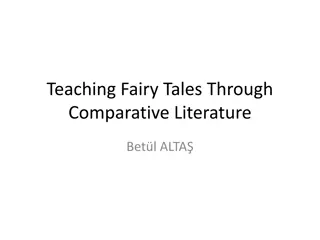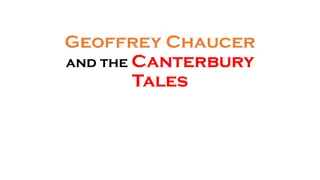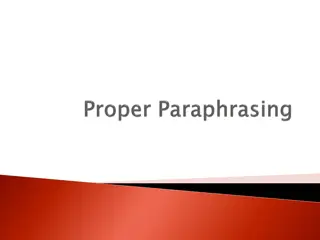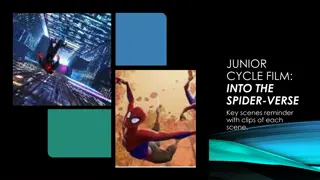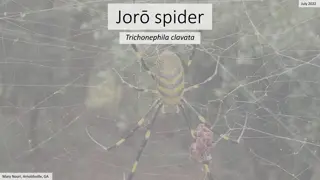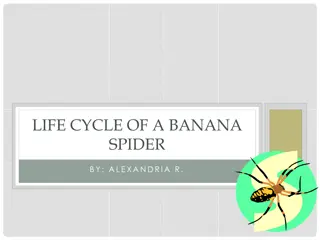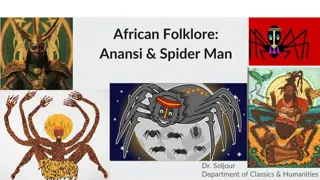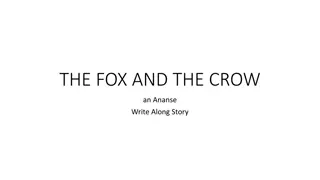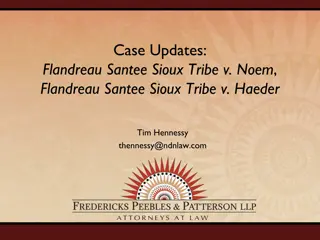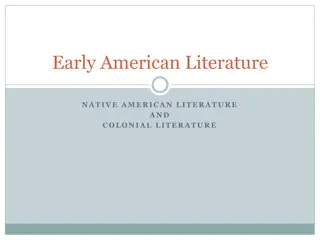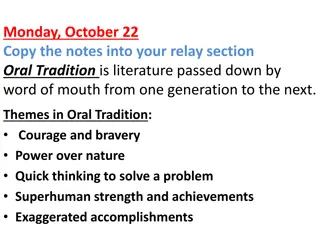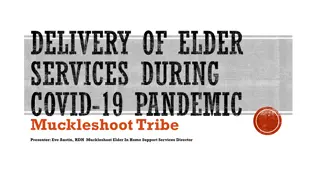Exploring Trickster Tales: The Hungry Spider and Ashanti Tribe
Discover the world of Trickster Tales through the Hungry Spider story from the Ashanti Tribe in Africa. Unveil the clever and mischievous characters, learn about the traits portrayed, and engage in critical thinking about the tale's moral lessons.
Download Presentation

Please find below an Image/Link to download the presentation.
The content on the website is provided AS IS for your information and personal use only. It may not be sold, licensed, or shared on other websites without obtaining consent from the author.If you encounter any issues during the download, it is possible that the publisher has removed the file from their server.
You are allowed to download the files provided on this website for personal or commercial use, subject to the condition that they are used lawfully. All files are the property of their respective owners.
The content on the website is provided AS IS for your information and personal use only. It may not be sold, licensed, or shared on other websites without obtaining consent from the author.
E N D
Presentation Transcript
Trickster Tales Theme One: Rogers Public Schools Grade Three (RL.3.2, RL.3.3, RL3.7)
What are Trickster Tales? A trickster tale is a kind of folktale told all over the world. The trickster is a clever animal or person who plays tricks on other characters. Often it s because the trickster is greedy or boastful. Sometimes though, another character outwits the trickster! Can you think of any trickster characters of whom you are familiar?
Genre Vocabulary Boastfulness Clever Culture Folktale Greediness Mischief Qualities Trickster Being full of praise for yourself Smart A group of people s customs, beliefs, and traditions A traditional story handed down by generations Selfishness Bad behavior Features that make a person special A character who plays tricks or pranks on others
Applying the Vocabulary boastfulness culture clever trickster greediness
Applying the Vocabulary culture mischief folktale qualities clever
Trickster Tale One Hungry Spider A Tale from Africa and the Ashanti Tribe Based on the title and the genre, what do you predict will happen in this story? When else have we read or learned about the Ashanti people? Told by Pleasant DeSpain
Character Traits Characters in folktales often have exaggerated traits or personalities. Authors reveal character traits through: descriptions dialogue (conversations) the character s actions and reactions Pay attention to the author s of character traits throughout the story.
Hungry Spider Story Map Steps Used in the Trick Problem Trickster Needs to Solve Trickster s Character Traits
Critical Thinking Why does the author begin the story with a description of the Spider? Why does Spider invite Turtle to dinner, even though he doesn t want to share his food? Why do you think Turtle invites Spider to dinner after Spider treated him so badly?
Lesson to be Learned What lesson can we learn from this story?
Trickster Tale Two Rabbit Races with Turtle Have you heard any versions of this trickster tale? Told by Gayle Ross
Problems and Solutions Trickster tales always have a problem and solution. As you read, think about the different problems and how each is solved. Problems Solutions
Critical Thinking How can you tell that this story is a trickster tale ? In Hungry Spider , how does politeness cause both Spider and Turtle to be tricked? What details in Rabbit Races Turtle a good trickster tale?
Genre Enrichment Look for details about this story that make it a trickster tale .
Trickster Tale Three Aunt Fox and the Fried Fish What will be the trick in this trickster tale? Told by Rafael Rivero Oramas
Descriptive Language This author uses descriptive language, or words that paint vivid pictures in the readers minds. In the story identify the different examples of descriptive words.
Critical Thinking What details does the author provide to show why Aunt Fox eats the fish? How is this story similar to and different from the other two trickster tales? Does this trickster tale teach a lesson or is it written just to be entertaining?
Trickster Chart Complete the story chart on page 180 of your practice book: You will be identifying the main parts of the three trickster tales we have read.
Wrapping up our Focus Compare the tricks played by the characters: Which do you think was the cleverest? Which one was the funniest? Do you think the characters had good reasons or bad reasons for playing tricks? Who was your favorite trickster and why?
Name: Tr ickst er Tales Comprehension Hungry Spider 1. How did the author describe Spider? _________________________________________________ _________________________________________________ ________ 2. What is the author s message, or lesson to be learned? _________________________________________________ _________________________________________________ ________ Rabbit Races with Turtle 3. What clues tell you that Turtle is a trickster character? _________________________________________________ _________________________________________________ ________ 4. How do Rabbit s feelings begin to change on page 292? _________________________________________________ _________________________________________________ ________ Aunt Fox and the Fried Fish 5. Why do authors use descriptive language?
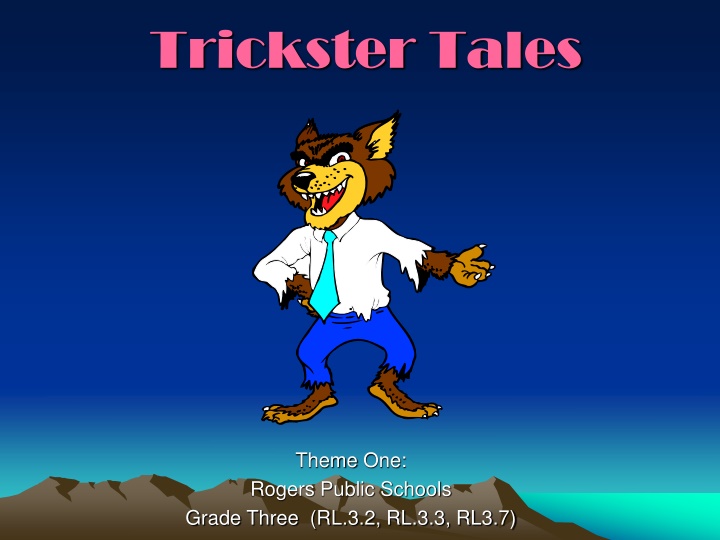

![READ [PDF] Trickster Caught: An Alien Gladiator Romance (Gladiators of the Vaga](/thumb/42236/read-pdf-trickster-caught-an-alien-gladiator-romance-gladiators-of-the-vaga.jpg)



